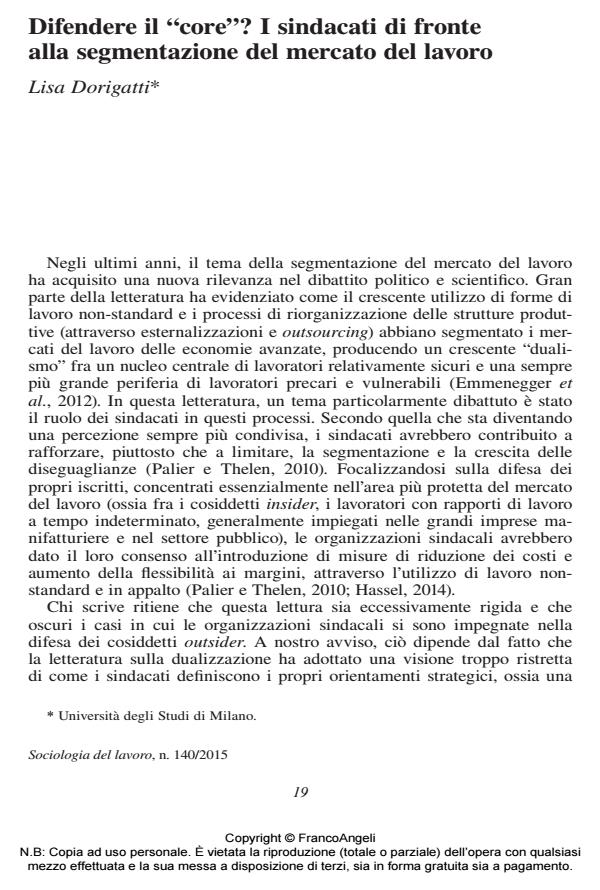Difendere il "core"? I sindacati di fronte alla segmentazione del mercato del lavoro
Titolo Rivista SOCIOLOGIA DEL LAVORO
Autori/Curatori Lisa Dorigatti
Anno di pubblicazione 2015 Fascicolo 2015/140
Lingua Italiano Numero pagine 14 P. 19-32 Dimensione file 97 KB
DOI 10.3280/SL2015-140002
Il DOI è il codice a barre della proprietà intellettuale: per saperne di più
clicca qui
Qui sotto puoi vedere in anteprima la prima pagina di questo articolo.
Se questo articolo ti interessa, lo puoi acquistare (e scaricare in formato pdf) seguendo le facili indicazioni per acquistare il download credit. Acquista Download Credits per scaricare questo Articolo in formato PDF

FrancoAngeli è membro della Publishers International Linking Association, Inc (PILA)associazione indipendente e non profit per facilitare (attraverso i servizi tecnologici implementati da CrossRef.org) l’accesso degli studiosi ai contenuti digitali nelle pubblicazioni professionali e scientifiche
Negli ultimi decenni, il tema della segmentazione del mercato del lavoro ha acquisito una nuova rilevanza nel dibattito politico e scientifico. All’interno di questa letteratura, un tema particolarmente dibattuto e stato il ruolo dei sindacati in questi processi. Secondo la letteratura sulla dualizzazione, essi hanno contribuito a rafforzare, piuttosto che a limitare, segmentazione e crescita delle diseguaglianze, dal momento che si sono focalizzati sulla difesa dei propri iscritti, concentrati essenzialmente nell’area piu protetta del mercato del lavoro. Attraverso l’analisi delle strategie adottate dalle organizzazioni sindacali dei settori chimico e metalmeccanico in Germania a fronte di processi di esternalizzazione e utilizzo di lavoro non-standard, lo studio mette in discussione questa prospettiva. Mostreremo come non necessariamente le organizzazioni sindacali escludano gli outsider. Cio dipende dal fatto che la difesa dei propri iscritti e solo una delle possibili motivazioni che definiscono l’azione sindacale. Inoltre, mostreremo come la stessa volonta di difendere gli interessi dei lavoratori piu stabili non porti necessariamente a un’esclusione dei lavoratori piu periferici, dal momento che una crescita di questi ultimi mette spesso in discussione anche la posizione dei primi. Rappresentare i lavoratori piu vulnerabili diventa, quindi, per le organizzazioni sindacali una necessita per difendere anche i lavoratori piu stabili.
Parole chiave:Segmentazione, strategie sindacali, insider/outsider, Germania
- Stratificazione, nocività e lavoro immigrato. il caso del distretto conciario della Valle del Chiampo Davide Marchi, in ECONOMIA E SOCIETÀ REGIONALE 1/2024 pp.61
DOI: 10.3280/ES2024-001005 - Diversity Management Policies for the Inclusion of LGBT People into the Labour Market: The Case of Naples Massimiliano Agovino, Fabio Corbisiero, in Papers in Applied Geography /2021 pp.50
DOI: 10.1080/23754931.2020.1815236
Lisa Dorigatti, Difendere il "core"? I sindacati di fronte alla segmentazione del mercato del lavoro in "SOCIOLOGIA DEL LAVORO " 140/2015, pp 19-32, DOI: 10.3280/SL2015-140002